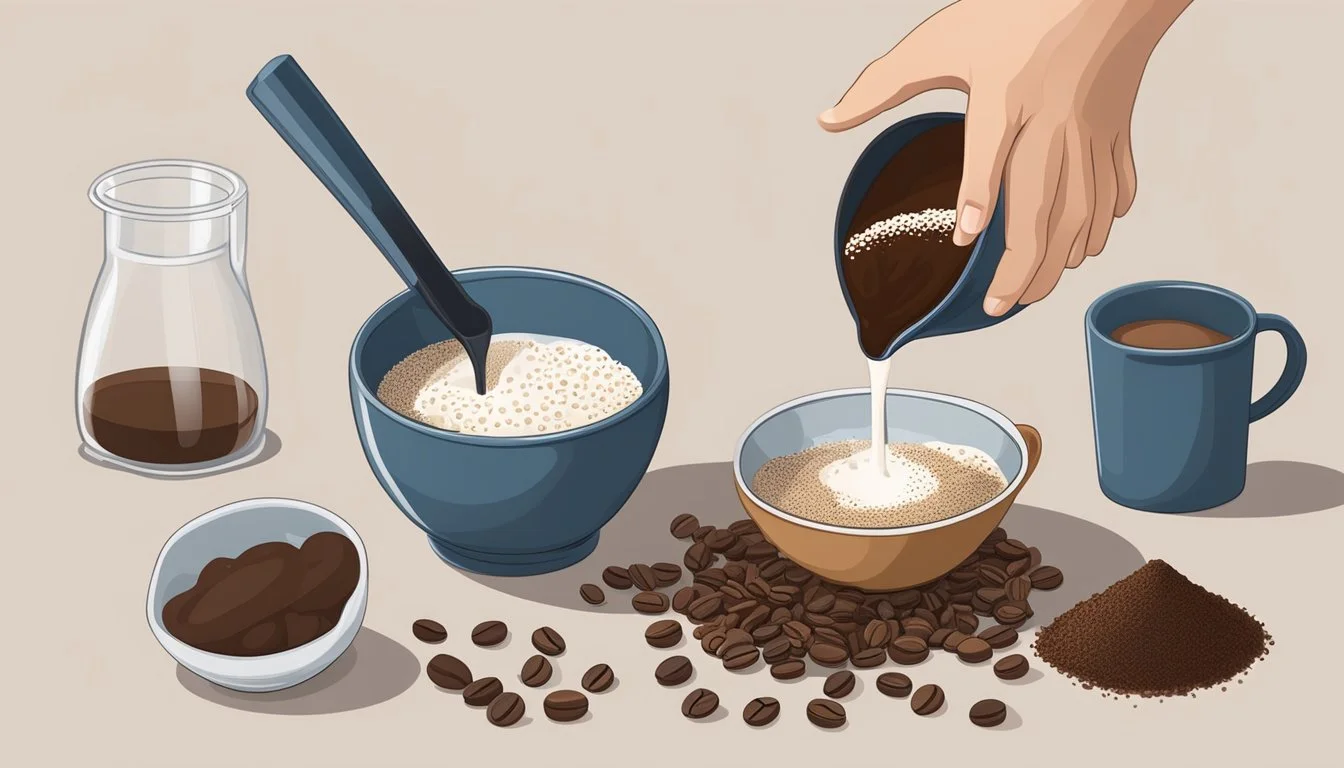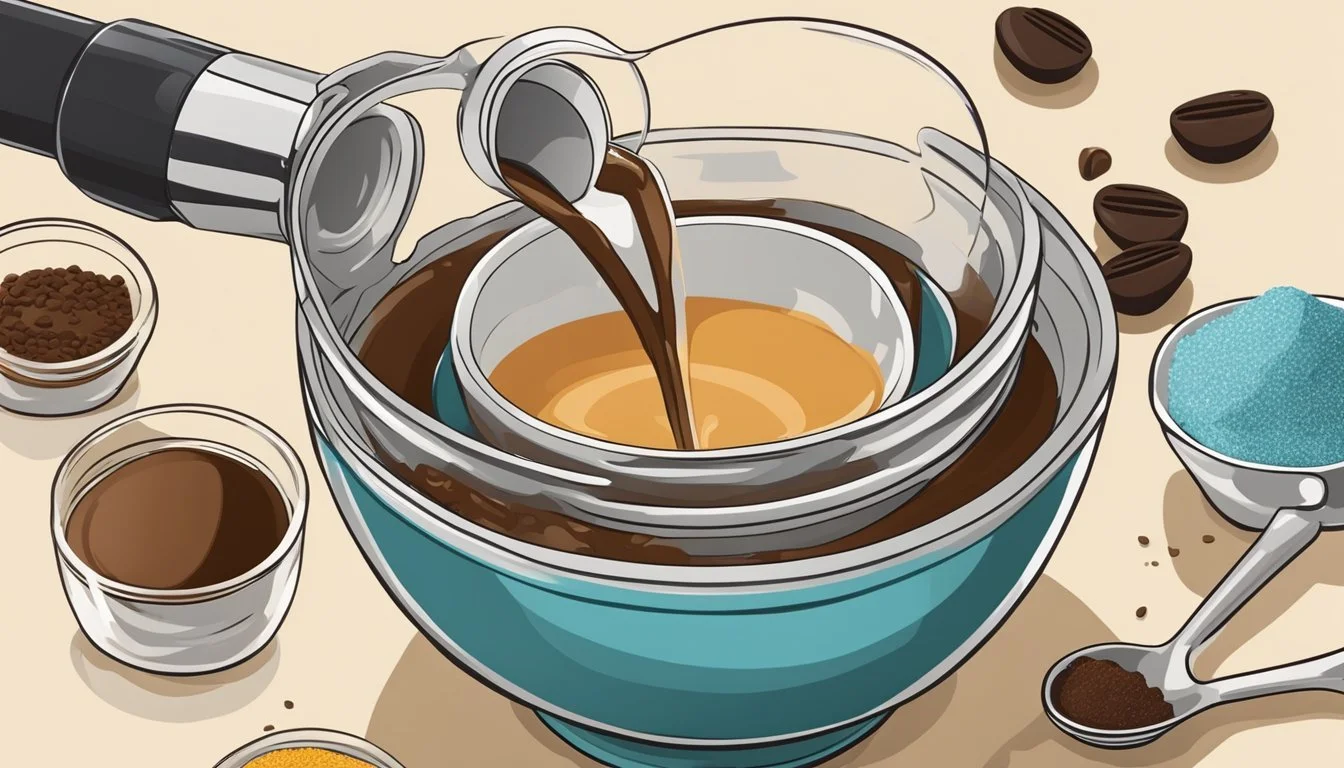How to Substitute Espresso for Coffee in Baking
Flavorful Tips for Desserts
Espresso, with its concentrated coffee flavor and dark, robust aroma, is a popular ingredient in baking. It enriches desserts (What wine goes well with desserts?) with a depth of flavor that regular coffee simply cannot match. However, not everyone has espresso on hand, and some may prefer to avoid its strong taste or higher caffeine content. This has led to the exploration of various substitutes that maintain the integrity of the desired coffee flavor in baked goods.
When looking to replicate the intensity and richness of espresso in baking, a common alternative is instant coffee. While less concentrated than espresso powder, instant coffee shares many similar flavor attributes. This makes it suitable for incorporating into chocolate desserts (What wine goes well with chocolate desserts?) or as part of a spice rub. The key is in understanding the potency difference and adjusting the quantity accordingly to achieve the desired outcome without overwhelming the palate.
For those seeking an option devoid of caffeine, or a different flavor profile, carob powder emerges as an intriguing substitute. Carob, being naturally sweet with an essence reminiscent of cocoa, can bring an entirely new dimension to baked goods without straying too far from the original purpose of using espresso. Its effectiveness in recipes depends on the other ingredients and the final taste profile bakers aim to achieve.
Understanding Espresso and Coffee in Baking
When incorporating coffee into baking, the type used can affect the end product's flavor and texture. This section breaks down the roles of espresso and coffee, their distinct flavors, and how they interact within baked goods.
Differences Between Espresso and Coffee
Espresso and coffee bring different flavor intensities and concentrations to baking. Espresso is a concentrated coffee brewed by forcing hot water through finely-ground coffee beans, while regular coffee is typically brewed by dripping hot water through coarser grinds, resulting in a less concentrated beverage. In baking, these differences influence not just taste but also moisture content.
Espresso: More concentrated, stronger flavor, less liquid required.
Coffee: Less concentrated, milder flavor, more liquid needed.
Impact on Flavor Profile
The incorporation of espresso or coffee into baked goods significantly alters their flavor profile. Espresso imparts a bold, robust coffee flavor which can enhance the complexity of chocolate flavors, making them richer and more pronounced. Regular coffee, being less concentrated, can add a subtler coffee taste.
Espresso: Enhances chocolate flavor, adds depth, may introduce a slight bitterness.
Coffee: Provides milder flavor, can sweeten without overpowering other ingredients.
Effect on Texture and Moisture in Baked Goods
Espresso and coffee contribute varying levels of moisture to baked goods, affecting both texture and structure.
Espresso: Due to its concentration, it requires less volume, reducing the overall liquid content, potentially yielding a denser, moister product.
Coffee: More volume might be needed to achieve the same flavor, which can impact the batter or dough consistency and final moisture level.
Careful consideration must be given to the balance of wet and dry ingredients to maintain the desired outcome in baked goods.
Types of Espresso Substitutes
When baking, the rich flavor of espresso powder can be pivotal for the desired taste profile. However, should you find yourself without it, several substitutes can deliver similar results. These alternatives can be utilized in various proportions to mimic the depth and complexity espresso powder brings to baked goods.
Instant Espresso
Instant espresso powder offers a concentrated coffee flavor, often used when a strong coffee presence is required in recipes. It is more robust than instant coffee powder but can typically be exchanged on a one-to-one basis with instant espresso powder when substituting.
Instant Coffee Powder
Instant coffee powder is less concentrated than espresso powder, offering a milder flavor. Bakers can substitute instant coffee powder directly for espresso powder, perhaps opting for a dark roast to closely match the intensity. In recipes, the ratio for substitution can be equal although some prefer to increase the amount slightly to achieve the richness of espresso.
Finely Ground Coffee Beans
If one prefers using actual coffee beans, they should opt for a dark roast and grind them to a fine consistency similar to that of espresso powder. While this method may not dissolve as completely as instant powders, it can introduce a fresh and potent coffee flavor to baked goods. One may need to experiment with the quantity used, starting with a one-to-one substitution ratio, and adjust based on taste and texture.
Cocoa Powder Alternatives
Cocoa powder can serve as an alternative to espresso powder, imparting a chocolaty flavor with an undercurrent of bitterness that can simulate the depth of coffee. Natural cocoa powder offers a more robust flavor due to its acidity, while Dutch-processed cocoa powder provides a milder option, as it's been alkalized. One may consider a mixture of cocoa powders or adding a small amount of instant coffee to the cocoa to enhance the coffee-like flavor profile in desserts.
Adjusting Liquid Ratios in Recipes
In baking, precise measurements are crucial, especially when substituting espresso for coffee. The balance between liquid and dry ingredients affects the texture and structure of the final product.
When to Reduce Liquids
When a recipe calls for instant espresso powder and it is replaced with brewed coffee or espresso, the overall liquid content increases. To maintain the recipe's integrity, one should reduce other liquid components, like milk or water, accordingly. For instance, if you add a quarter cup of brewed coffee, consider reducing the milk or water by the same amount to keep the batter consistent.
Balancing Dry and Wet Ingredients
Substituting espresso for coffee affects the moisture content of the batter or dough. A recipe's success hinges on the balance between dry and wet ingredients. To ensure the batter doesn't become too wet when adding liquid coffee, bakers may need to slightly increase the amount of dry ingredients, or they must reduce another liquid in the recipe. Here's a simple guide:
For 1 tablespoon of instant espresso powder, replace with:
1 tablespoon of liquid espresso or strong brewed coffee
Reduce other liquids in the recipe by 1 tablespoon
Keep precise measurements to avoid altering the texture and structure of the baked goods. The goal is to integrate the coffee flavor without compromising the recipe's intended outcome.
Incorporating Espresso into Different Desserts
Espresso can elevate the flavor profile of various desserts, adding a sophisticated twist to traditional recipes. By integrating espresso appropriately, one can enhance the richness and complexity of chocolate desserts, lend a robust edge to cakes (how long do cakes last?) and brownies, and impart nuanced depth to cookies and sweets.
Chocolate Desserts Enhancement
In chocolate desserts, espresso is particularly effective in intensifying the chocolate flavor. A small amount of instant espresso powder added to the chocolate mixture can lead to a more pronounced and rich cocoa taste. For a typical chocolate ganache or mousse, incorporating about a teaspoon of espresso powder into the recipe can make the chocolate notes more robust and flavorful.
Coffee-Infused Cakes and Brownies
When it comes to cakes and brownies, espresso can be used in liquid form or as a powder. A common method is to dissolve espresso powder in the liquid ingredients of the cake or brownie batter. Alternatively, substituting part of the liquid with a strong brewed espresso can infuse the baked goods with a subtle coffee aroma and taste. To prevent the espresso from overpowering, one should start with a small quantity and adjust according to taste.
Dessert Type Suggested Espresso Addition Chocolate Cake 1-2 teaspoons espresso powder or 1/4 cup brewed espresso Brownies 1 teaspoon espresso powder or 2 tablespoons brewed espresso
Creating Depth in Cookies and Sweets
Espresso can add dimension to the taste of cookies and sweets. A dash of espresso powder in cookie dough not only enhances its coffee flavor but also complements other ingredients like nuts and chocolate chips. It's essential to balance the quantity of espresso to ensure that the unique flavors of the cookies and sweets remain distinct while gaining complexity from the espresso.
For sugar cookies or oatmeal cookies, about 1/2 teaspoon of espresso powder can be added.
In chocolate chip cookies, up to 1 teaspoon can deepen the flavor without overwhelming the sweetness.
By carefully integrating espresso into such desserts, bakers can create treats with a nuanced depth that appeals to the palate of those seeking more from their sweets.
Alternative Uses of Espresso in Baking
Espresso's rich and bold flavor can transform baking recipes beyond traditional desserts. Espresso's contribution to savory dishes and specialized desserts like Tiramisu is truly distinctive.
Savory Applications
Espresso powder, when used in savory baking, imparts a profound depth of flavor. It can be incorporated into bread doughs to create loaves with a unique taste profile, enhancing the inherent flavors of the other ingredients.
Espresso Rubs for Meats
A spice rub blend that incorporates espresso grounds can add a complex, smoky layer to meats.
2 tablespoons espresso grounds
1 tablespoon brown sugar
2 teaspoons salt
1 teaspoon black pepper
1 teaspoon garlic powder
1 teaspoon onion powder
Combine the ingredients for a balanced rub that complements the rich taste of meats like steak.
Specialty Baking and Tiramisu
Espresso holds a special place in Italian desserts, particularly Tiramisu. It's used to both soak the ladyfingers for structure and flavor, and also blended into the mascarpone cheese mixture. Authentic Tiramisu relies on the distinct taste of espresso, which, when combined with a touch of sugar and fat, balances the dessert's sweet and creamy components.
Tips for Working with Espresso Substitutes
When substituting espresso with alternative coffee forms in baking, one must pay close attention to the texture and potency differences. The goal is to achieve a flavor profile that complements the baked goods without overwhelming them.
Dissolving and Hydrating Powders Properly
To ensure a smooth texture in baked items, dissolving the powder completely is crucial. For instance, instant espresso or granulated substitutes like chicory coffee need to be fully hydrated to prevent a gritty texture.
Instant Espresso: Stir the granules into a small amount of hot water until they dissolve completely. Use an equal amount of hot water as the espresso powder called for in the recipe to maintain flavor integrity.
Chicory Coffee: A caffeine-free alternative is chicory coffee, which should also be dissolved in hot water before use, using the same ratio as above to ensure the correct moisture content is added to the batter or dough.
Storing and Shelf Life of Substitutes
Substitutes for espresso powder require proper storage to maintain their quality. Since these products are processed and dehydrated, they have a good shelf life when stored in a pantry under the right conditions.
Pantry Storage: Keep your substitutes in an airtight container away from heat and moisture to prevent clumping. This will also protect the potency of the product.
Shelf Life Considerations:
Processed Powders: Typically, processed powders like instant espresso can last up to two years if stored correctly.
Brewed Coffee: If a recipe calls for a liquid like brewed coffee, use it fresh to avoid a stale taste in your baked goods.
Health Considerations and Caffeine Content
When substituting espresso for coffee in baking, one must consider the health impact, primarily due to caffeine content and its associated bitter notes, while also taking into account options for those seeking unsweetened or caffeine-free alternatives.
Comparing Caffeine Levels in Substitutes
The caffeine content in espresso is higher than in regular coffee on a per ounce basis. However, because espresso is often used in smaller quantities, the total caffeine content in a dessert may be comparable to that of dishes using regular coffee. For instance, a single shot of espresso may contain approximately 63 mg of caffeine, while an 8 oz cup of coffee generally contains 95 mg. Here is how common substitutes compare:
Instant Coffee: Similar caffeine content to regular coffee; varies by brand.
Strong Brewed Coffee: Slightly lower in caffeine than espresso when used in equal quantities.
Decaffeinated Options
For those sensitive to caffeine or preferring a caffeine-free dessert, decaffeinated substitutes are available. These options still impart the desired coffee flavor without the stimulating effects. It's important to note that even decaffeinated coffee contains trace amounts of caffeine.
Decaffeinated Instant Espresso: Maintains the flavor profile with minimal caffeine.
Decaffeinated Regular Coffee: Found easily and can be used as a direct substitute.
In recipes where bitter notes are essential, the removal of caffeine can slightly alter the flavor profile, but these can be adjusted by adding minute amounts of unsweetened cocoa powder or chicory to mimic the bitterness.
Transforming Traditional Recipes with Espresso
Espresso can elevate traditional baking recipes by adding a rich, complex flavor that subtly enhances the existing taste profile. The use of espresso provides an opportunity to reinvent classics and inspire innovative dessert creation.
Modifying Classics with an Espresso Twist
Incorporating espresso into classic recipes offers a creative way to infuse new life into time-honored favorites. For instance, a simple addition of brewed espresso or espresso powder can transform a basic chocolate cake into a mocha delight. When integrating espresso into recipes:
Chocolate Desserts: Add one to two teaspoons of espresso powder to deepen the chocolate flavor.
Spiced Treats: Complement spice-heavy recipes, like gingerbread or pumpkin spice cake, with a hint of espresso to add a warm, toasty undertone.
It's critical to consider the strength of the espresso and how it interacts with other ingredients. For example, too strong an espresso addition might overshadow delicate flavors in certain pastries.
Innovative Espresso-Based Recipe Ideas
Creativity flourishes with espresso as bakers experiment with its versatile application in an array of baked goods. They can explore beyond traditional desserts and incorporate espresso into:
Coffee-Infused Frostings: Use finely ground espresso beans to create a robust coffee-flavored frosting for cupcakes or cookies.
Espresso Glazes: A thin glaze made with espresso can provide a subtle coffee hint to scones and doughnuts.
By experimenting with substitutes, such as instant coffee or a homemade brew of dark-roasted espresso beans, chefs can tailor the strength and depth of coffee flavor to the specific needs of their recipe. This adaptation ensures that both aficionados of strong coffee flavors and those preferring a milder taste can enjoy the innovative espresso-based dishes.
Conclusion
When bakers seek to replace espresso with another ingredient, they have a variety of substitutes at their disposal. These alternatives allow for a confident approach to recipe modifications, ensuring the desired depth of flavor is achieved in the finished product.
Key Substitutes:
Instant Coffee: Less concentrated, yet a simple 1:1 ratio proves effective for most recipes.
Carob Powder: Offers a similar flavor profile, being a natural coffee substitute.
Dutch-processed Cocoa Powder: Alkalized to reduce bitterness, ensuring a smoother taste.
The successful integration of substitutes hones bakers' skills, expanding their flavor horizons and versatility. The key is understanding the nature and characteristics of the selected alternative to match the intensity espresso imparts.
For robustness: Increase the quantity of instant coffee slightly.
For a coffee-free option: Carob powder can replicate the coffee essence.
Achieving Balance: Substitutions should be introduced with consideration for other ingredients' ratios and properties to maintain the overall balance of the bake.
Adopting these substitutes allows bakers to navigate ingredient constraints with ease. It also opens up new possibilities in flavor combinations and texture outcomes. With this knowledge, bakers can adapt any recipe to their taste preferences or dietary needs while still producing delectable results.










